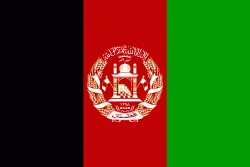Malistan District (Mālistān)
Malistan or Malestan is a district in the west of Daykundi Province, Afghanistan. Its population, which is 100% Hazara, was estimated at 350,000 in 2009. The district capital is Mir Adina.
During the period of Dost Mohammad Khan in the 1830s the area operated as part of the semi-autonomous area of Hazarajat. In 1949 the area was separated from Jaghori District. During the Soviet occupation, Maoist resistance groups were particularly active. After Harakat lost in Qarabagh of Ghazni in 1985 to Nasr, the political organizations united to force out Hizb-e Islami from the districts of Jaghori and Malistan. However, there were only sporadic clashes here and the central government lacked interest in Malistan. Around 1997, as the Taliban began to take control of Hazarajat the area was put under food blockade, leaving approximately 1 million Hazaras on the bring of starvation, including those in Malistan.
In 2002, plans were drawn up to split Malistan into four separate districts, in order to ease access to the judation, government office, huge population, and distance area from Miradina, these plans are not believed to have been carried through. From 2002 to 2008 approximately 3,801 refugees repatriated through the UNHCR system, although only 35 were listed as returning in 2008 and the fact majority occurring in 2002–04.
During the period of Dost Mohammad Khan in the 1830s the area operated as part of the semi-autonomous area of Hazarajat. In 1949 the area was separated from Jaghori District. During the Soviet occupation, Maoist resistance groups were particularly active. After Harakat lost in Qarabagh of Ghazni in 1985 to Nasr, the political organizations united to force out Hizb-e Islami from the districts of Jaghori and Malistan. However, there were only sporadic clashes here and the central government lacked interest in Malistan. Around 1997, as the Taliban began to take control of Hazarajat the area was put under food blockade, leaving approximately 1 million Hazaras on the bring of starvation, including those in Malistan.
In 2002, plans were drawn up to split Malistan into four separate districts, in order to ease access to the judation, government office, huge population, and distance area from Miradina, these plans are not believed to have been carried through. From 2002 to 2008 approximately 3,801 refugees repatriated through the UNHCR system, although only 35 were listed as returning in 2008 and the fact majority occurring in 2002–04.
Map - Malistan District (Mālistān)
Map
Country - Afghanistan
 |
 |
| Flag of Afghanistan | |
Human habitation in Afghanistan dates back to the Middle Paleolithic era, and the country's strategic location along the historic Silk Road has led it to being described, picturesquely, as the ‘roundabout of the ancient world’. Popularly referred to as the graveyard of empires, the land has historically been home to various peoples and has witnessed numerous military campaigns, including those by the Persians, Alexander the Great, the Maurya Empire, Arab Muslims, the Mongols, the British, the Soviet Union, and most recently by a US-led coalition. Afghanistan also served as the source from which the Greco-Bactrians and the Mughals, amongst others, rose to form major empires. The various conquests and periods in both the Iranian and Indian cultural spheres made the area a center for Zoroastrianism, Buddhism, Hinduism, and later Islam throughout history.
Currency / Language
| ISO | Currency | Symbol | Significant figures |
|---|---|---|---|
| AFN | Afghan afghani | Ø‹ | 2 |
| ISO | Language |
|---|---|
| PS | Pashto language |
| FA | Persian language |
| TK | Turkmen language |
| UZ | Uzbek language |















